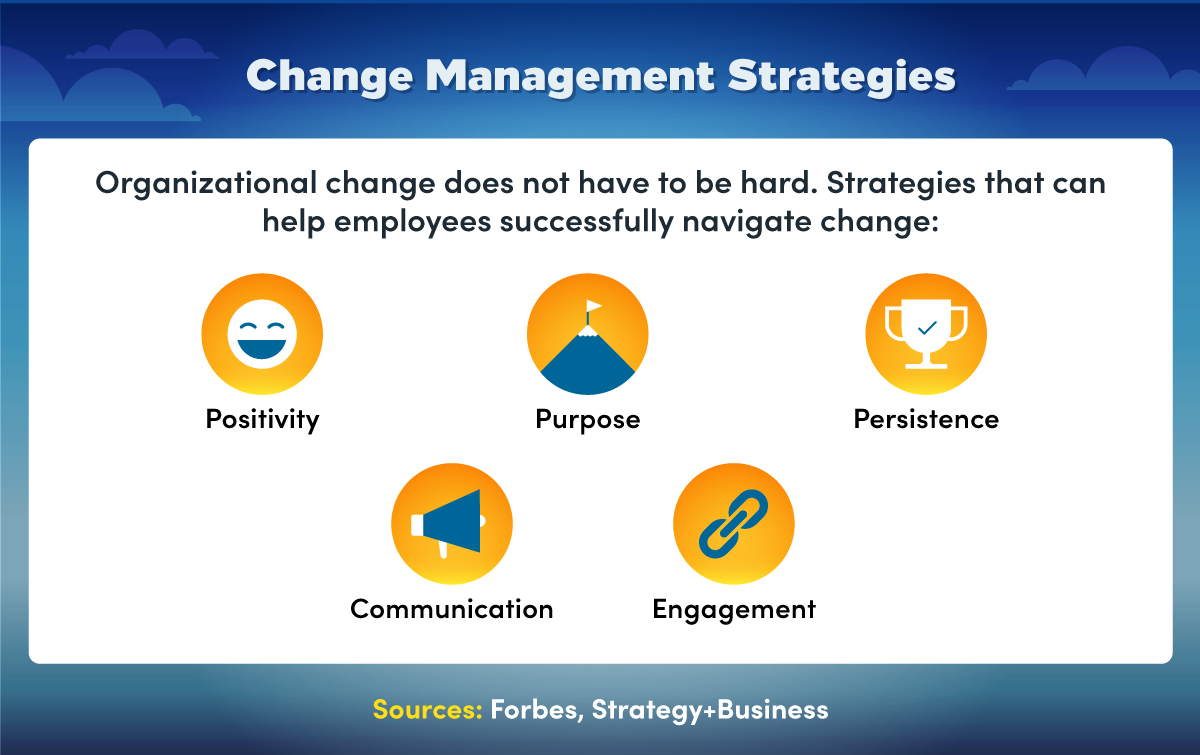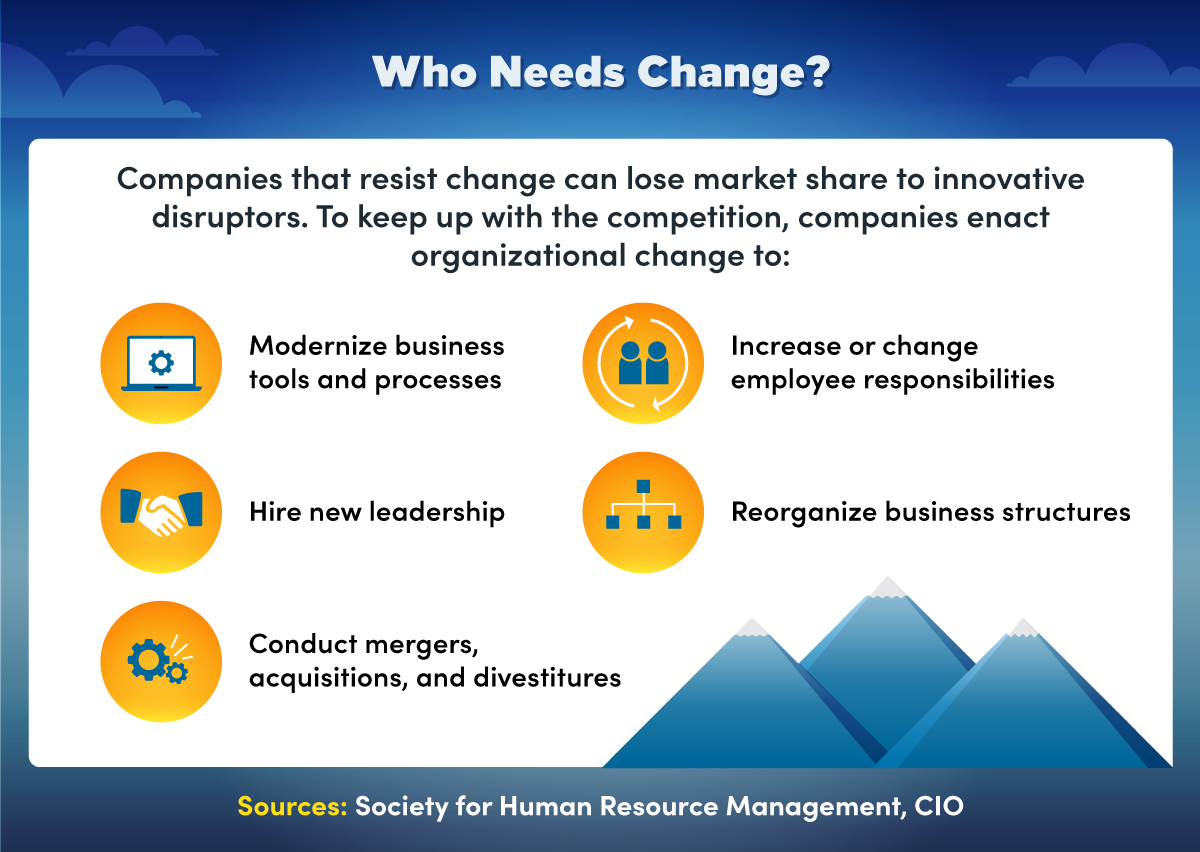Organizational Change Management Guide for Developing Innovators & Leaders

Tables of Contents

Organizational change can range from a digital transformation to a new CEO. When a major transition occurs — whether with tools, processes, or people — businesses must ensure that operations run smoothly and employees are on board with the change. If companies aren’t prepared for potential disruptions in the process, organizational change goals may not be achieved.
When organizational change management techniques are applied, companies can more easily navigate complex transitions. For instance, if employees resist change, companies can provide clear, consistent guidance to help them adapt to new processes and tools. With a solid transformation plan, businesses can assess progress and gather feedback along the way to ensure that milestones are met.
Organizational change management is also key to maintaining a positive work culture. When a change is thrust on employees without establishing a trusting and supporting environment, an organization’s culture will suffer.
What Is Organizational Change Management?
Organizational change management is the human element of organizational change. It involves applying a people-focused structure to business transitions to ensure positive benefits. When a business moves toward a desired future state, leaders must make sure that employees aren’t left behind. Leaders looking to improve their change management skills will need to develop competencies in both business management and psychology.
Businesses undergo transformations for a variety of reasons. They may be working to expand into new fields, strengthen a market position, reduce costs, or improve operational efficiencies. Change management is a systematic approach that applies specific tools, resources, and knowledge toward minimizing the negative outcomes of such transitions.
In this article, we will explore the types of change management that occur, and the strategies companies use to effectively navigate change. We will also examine some examples of companies that have conducted successful change management programs — such as Apple’s transformation into a provider of modern, desirable products — as well as companies that failed to overcome change management challenges.
Why Is Change Management Important?
To understand what organizational change management is, one must be familiar with why it’s important. Effective change management techniques can help companies successfully enact a number of positive transitions, such as:
- Adopting new technology systems
- Solidifying new processes
- Integrating acquired businesses
- Restructuring departments and leaders
If employee engagement and satisfaction aren’t taken into account during transitions, new systems and processes may be rejected, leaving businesses with major expenses and broken workflows. A strong sense of teamwork is essential to enacting change efficiently and keeping cost controls in place, especially as firms are increasingly looking to achieve productivity gains.
Rapid advances in technology are also driving demand for efficient change management. As companies scramble to adopt the latest data analysis tools, automate processes, and explore artificial intelligence, it becomes essential to have a nimble and knowledgeable workforce. Workers need to be innovative and transition easily into new roles.
Who Conducts Change Management?
When a company is planning a major transformation, such as going public or launching a key product, it may form a change team of executives and staff managers. All members of the team need to gain familiarity with change management concepts to help guide and support employees during the process.
The team is often led by a change management specialist, who can share expertise in transition strategies. This leader may be a human resources (HR) manager with a background in organizational change or a top company executive, such as the CEO.
Organizational Change Management Strategies
Organizational change can be challenging, requiring careful planning and well-established procedures to gain employee acceptance and cooperation. An organization may have to shift philosophies and targets many times during a transition, making a strong, flexible set of guidelines essential for success.

Planning for Change
An organization must go through a number of planning stages to prepare for impending changes.
1. Create a change team:
Businesses must identify the members of management who need to be directly involved in the transition planning stages. This typically includes top executives, human resources professionals, and managers of key departments. Executives must determine how the team will function, including assigning tasks and responsibilities to certain members, setting meeting times, and outlining communication methods. This team will establish the vision and set the goals to be communicated across the organization during the change.
2. Assess the impact:
How large is the change? How many departments will be impacted, and to what extent? What job roles will need to be updated? What expenses will be incurred? Companies need to look at the existing organizational structure to see how it’ll hold up under change. Workers and managers with new skill sets may need to be recruited, and employees with useful traits may need to be reassigned to more relevant roles.
3. Create a timeline:
The change team needs to create a timeline for how the transformation will be rolled out to managers and employees. Some larger transitions may need to be implemented in stages. The team should also set measurements for success and identify potential barriers that could slow progress along the way.
4. Identify potential people issues:
Leaders must anticipate how workers might react to cultural or job changes, especially if workloads are increased. The adoption of new tools and processes can create major frustrations and require extensive managerial support. Peer layoffs can also have a negative impact on remaining employees. A company may need to use assessment tools, such as self-evaluations, to determine workforce readiness. They may also need to set up coaching or counseling resources to make sure employees have the necessary psychological support needed to navigate the change.
5. Notify key employees:
Once the change team establishes its strategies, it must make sure that all of the organization’s leaders and managers are on board with the change before rolling it out to employees. These managers will be responsible for educating team members on the vision and expectations involved in the transition plan and must be prepared to provide extra training and moral support.
Strategies for Change
Well-developed organizational change management strategies can result in greater efficiencies, stronger teamwork, and improved financial results. Businesses must take the time to develop the right strategies to avoid negative outcomes.
- Communicate honestly. Leaders should make sure that the reasons for change are easy to understand. A sense of urgency should be created around why the business needs to transform, whether to combat competitive challenges, meet changing customer needs, or upgrade to modern technologies that will enhance the business.Communication lines should be kept open so that employees can contribute. Sugarcoating the reasons for a change and the challenges that will come with it only alienates workers and creates distrust.
- Engage employees. Employees need to believe that the change will improve the business and that they’ll benefit from the transition. Organizational transformations are most successful when workers feel involved, empowered, essential, and supported.Companies can offer coaching programs, personal development tools, and rewards systems to help maintain positive morale. Employee input should be gathered throughout the process to determine if the strategies or timelines should be adjusted.
- Show positivity. Leaders of change initiatives can appeal to employees’ emotions by creating excitement around achieving the new corporate vision. When workers struggle with change, they need positive encouragement and inspiration from their managers.Managers can show empathy by recognizing how anxiety and fatigue can impact performance, according to the article “10 Principles of Workforce Transformation” from Strategy+Business. Leaders should avoid imposing negativity on employees by expressing their own anger or doubts.
- Enact visionary change. Though organizational change often equals progress, employees benefit from a sense of stability and purpose. Leaders should connect the new, transformational vision to the company’s long-term strategy, while honoring the organization’s history and past successes. When workers have a clear picture of where the company has been and where it’s going, they’re more invested in the transformation.
- Be persistent. Organizational transformations don’t take place overnight. Most successful transitions are rolled out gradually to keep operations flowing smoothly. Leaders should show persistence in monitoring change and pivoting when the direction strays from the goals.The transition team needs to revisit goals and timelines throughout the transition to determine whether adjustments are needed. Frequent surveys can help leaders gauge employee commitment, and interventions may be needed for groups or individuals struggling to accept the change, according to this organizational transformation guide from CIO contributor Bart Perkins. In addition to persistence in carrying out these steps, leaders must show patience in allowing employees the time they need to adjust to change.
- Use online tools and resources. A number of tools can be useful for organizational change planning and deployment.
- Prosci ADKAR Model — a model for planning change management programs
- Creately — an online tool for creating flowcharts and other change diagrams
- Gantt chart — a timeline tracking chart for change programs
- The Change Compass — a cloud-based platform for change analytics and planning
- The Change Shop — a software platform for tracking change management tasks
- John Kotter’s 8-Step Process for Leading Change — a guide for leading organizational change
Organizational Change Examples
Organizational change can encompass a wide number of situations, from bankruptcies and workforce reductions to acquisitions and product transformations. These changes are necessary across the largest corporations and the smallest businesses, as all organizations must regularly shift strategies to follow competitive trends and customer expectations.

Common Organizational Changes
Some of the most common organizational changes include changes in processes, leadership changes, and company restructurings, according to the Society for Human Resources Management.
New process or programs, including digital transformation.
Organizational change management programs are often enacted when companies are adopting new technologies, such as transitioning to the cloud or implementing a new customer relationship management (CRM) system. Digital transformation is increasingly common, with offices transitioning to remote work and retailers shifting to online ordering and delivery. Companies may also be changing a major process, such as how new customers are onboarded.
New job tasks.
When companies shift to newer products or work to improve efficiencies, employees may be asked to change roles. Some job reassignments come as a result of cost reductions, layoffs, outsourcing, or process automation efforts, making it more difficult to maintain employee satisfaction.
New leaders.
When a business is struggling, it will often shake up the upper management structure. Bringing in a new CEO, president, sales leader, or marketing manager can be an effective way of enacting new visions and breaking down the status quo when operations become stagnant.
Reorganization of business units or departments.
Companies often restructure business units to improve efficiency. A large enterprise may position the marketing department more closely with sales representatives to improve customer messaging, for example. A restructuring may also come as companies face regulatory changes that alter how business processes can occur.
Corporate merger and acquisition events.
Companies conduct acquisitions to expand their operations or achieve certain financial objectives. When two business cultures are combined, adjustments must be made to strategies and processes to successfully accomplish the new corporate goals.
Notable Examples of Organizational Change
Companies have varying levels of success in rolling out organizational change. More than 70% of companies undergoing digital transformation experienced slowed or stalled progress during a transition, according to a recent survey from McKinsey & Company. The reasons for derailment included resourcing issues, unclear digital strategies, insufficient commitment, misaligned cultures, and lack of core competencies. Some 36% of organizations were able to regain momentum once challenges were addressed.
Successful Transformation Cases
The following articles document successful examples of organizational change:
- Amazon’s evolution. In a matter of decades, Amazon evolved from a small online bookstore into a global online retail powerhouse. Amazon invested heavily in technology from the beginning, staying ahead of competition from larger booksellers by providing customer-friendly online sales tools. It gradually widened its online offerings; expanded overseas; and branched into web hosting, electronic, robotics, and other fields. Amazon now accounts for nearly half of U.S. online retail sales.
- Apple’s revolution. Apple was on the verge of bankruptcy in 1997 when it received a cash infusion from Microsoft and underwent a major restructuring led by co-founder Steve Jobs. Apple gradually overhauled its product offerings, creating modern, desirable products including the iMac and iBook. The firm created a nimble, out-of-the-box design strategy that allowed it to meet customer needs, and Jobs led the firm to massive success with the launch of the Apple Store, iPod, iTunes, and iPhone.
- Toyota’s production system. One of the best-known transformation stories is Toyota’s development of what’s now known as the lean manufacturing philosophy. The strategy focused on eliminating waste in manufacturing processes, keeping minimal products in inventory, and pivoting quickly when improvements were needed. The philosophy made Toyota one of the top global carmakers, and thousands of companies around the world have adopted lean operating processes.
Failed Transformation Cases
There are also many examples of organizational change that weren’t so successful. These companies typically failed to consider customer desires, competitors’ innovations, and employee input when formulating their business development plans, leaving them with an ineffective vision and strategy.
- Blockbuster’s rise and fall. Blockbuster’s collapse is a classic example of a company failing to keep up with the competition. The company formed an innovative business model for rapid growth in the movie rental store industry, but focused too closely on growing its brick-and-mortar chain and botched an attempt to compete with Netflix in the mail-order and digital movie marketplace.
- Motorola’s failure. The dawn of the smartphone brought on deep organizational challenges for Motorola, despite the company’s history of innovation and risk taking. The company failed to recognize a culture shift in how consumers wanted to use their cellphones, and internal discord among management led to a sharp decline in innovative product launches.
- The downfall of the once-top retailer Sears. Like many other brick-and-mortar retailers, Sears struggled to keep pace with online competition. The company filed for bankruptcy after closing hundreds of stores. Its downfall was largely blamed on top management’s unwillingness to invest in updating stores or bringing in new product offerings, focusing instead on cutting expenses in the face of slowing sales.
How to Change Organizational Culture
An organizational culture is a shared set of beliefs regarding the company’s strategy and vision. In a strong corporate culture, employees know what behaviors are expected and strive to reflect the organization’s values. The most successful companies tend to have a strong organizational culture, with the leadership team sharing the same cultural priorities and making those values clear to the entire organization, according to the Society for Human Resource Management.
Why Is Organizational Culture Important?
Workplace transformations typically involve a shift in culture. Companies that are looking to enact organizational change have a greater chance of success when their corporate culture is well defined and appreciated by employees.
In some cases, a company’s culture has been the same for decades, which can result in a lack of progress toward company goals. A company’s culture may also have been damaged through past transition programs that were unsuccessful. In such cases, an organization may need to refresh its culture before embarking on an organizational change journey.
Steps for Changing Organizational Culture
Leaders who familiarize themselves with organizational change management strategies will gain a greater understanding of how to change organizational culture. Some of the steps that leadership teams take in enacting cultural change include the following:
1. Assess existing culture and values.
Leaders must define the existing culture before strategizing for change. Does the current mission statement resonate with employees, or is it outdated? Is the culture agile enough to adapt to major organizational changes? Did any past transformations or leaders contribute to the culture?
2. Set organizational goals.
Companies must determine where they want to be in the future and what behavioral norms will help them get there. Organizational goals include a keystone change — such as improving revenue or adding customers — but also include smaller ambitions, such as enhancing employee satisfaction or adding new training programs.
3. Implement transformation slowly.
A cultural change can’t be forced on employees, but must be implemented in stages. A committee of leaders and managers may engage in gathering input about common values. Engaging employees in creating a new vision and strategy can boost the success of a cultural shift.
4. Coach team members.
Depending on past company practices, firms may need to train employees in new technology skills or productivity methods. Support groups and individual coaching sessions can help keep workers engaged during transformation processes. Hiring an external coach can help with motivation and personal development.
5. Monitor progress.
Companies should stay flexible and be open to pivots in cultural ideals. Organizations may enact rewards and recognition programs to help encourage employees to adopt shared behaviors. Firms can also use performance management programs to help outline expectations and provide a channel for feedback. Companies can also take periodic surveys to assess cultural changes.
Resources for Organizational Change Management
The following organizations and resources may be helpful for individuals looking to grow as organizational leaders and who understand the importance of organizational change management:
- Association of Change Management Professionals: Membership association connecting companies with change management resources and professionals
- Project Management Institute: Project management organization providing articles and tools for change management and related topics
- Change Management Institute: Global nonprofit organization promoting professional development in change management
- Prosci: Change management firm providing training programs and resources
- Society for Human Resource Management: Membership organization for HR professionals and business leaders
- McKinsey & Company: Management consulting firm providing articles and reports on business transformation and related topics
Additional Sources
Association of Change Management Professionals, What Is Change Management?
Forbes, “8 Steps to Implementing Successful Organizational Change”
Forbes, “Four Ways Coaching Can Be Useful Amid Organizational Change”
Harvard Business Review, “4 Tips for Managing Organizational Change”
The Digital Product Manager, “List of My Favorite Change Management Tools of 2020”
Whatfix, “15 Change Management Tools to Effectively Manage Organizational Change”

